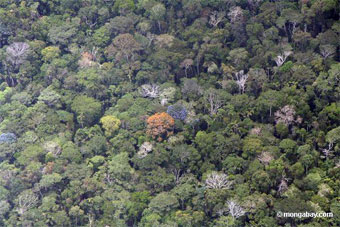Scientists endorse radical plan to save rainforests through emissions trading
Scientists endorse radical plan to save rainforests through emissions trading
mongabay.com
May 19, 2006
The Association for Tropical Biology and Conservation (ATBC), the world’s largest scientific organization devoted to the study and wise use of tropical ecosystems, has formally endorsed a proposal to help save tropical forests through carbon trading.
Under the initiative proposed by an alliance of fifteen developing countries led by Papua New Guinea and Costa Rica, tropical nations that show permanent reductions in deforestation would be eligible to receive “international carbon funds” from industrial nations who could purchase carbon credits to help them meet their emissions targets international climate agreements like the Kyoto Protocol.
“It’s as close to a win-win situation as one sees these days,” said ATBC president Dr William Laurance, a biologist with the Smithsonian Tropical Research Institute in Panama. “The forests win, the climate wins, and impoverished people in developing nations win.”
Tropical forests have the best potential for mitigating rising concentrations of greenhouse gases since have the greatest capacity to store carbon in their tissues as they grow. Some experts estimate that the reforestation of 3.9 million square miles (10 million square km) could sequester 100-150 billion metric tons of carbon dioxide over the next 50-100 years.
While forest growth absorbs carbon from the atmosphere, deforestation and forest degradation does the opposite, releasing carbon dioxide, a potent greenhouse gas blamed for contributing to global warming. The UN estimates that 20-25 percent of greenhouse gas emissions come from the destruction and degradation of forests, an amount similar to the volume produced each year by the United States.
 Peruvian rainforest. Photo by Rhett Butler Avoided deforestation could help fight third world poverty under global warming pact — 10/31/2006 |
Analysis of U.N. data by mongabay.com shows that tropical deforestation rates increased 8.5 percent from 2000-2005 when compared with the 1990s, while loss of primary forests expanded by almost 24 percent over the same period. Overall, the U.N. estimates that 10.40 million hectares of tropical forest were permanently destroyed each year in the period from 2000 to 2005, an increase since the 1990-2000 period, when around 10.16 million hectares of forest were lost.
Deforestation of tropical rainforests has a global impact through species extinction, the loss of important ecosystem services and renewable resources, and the reduction of carbon sinks. Recently a study by NASA found a direct impact that tropical deforestation has on the economies of the United States and Europe. Research shows that deforestation in the Amazon region of South America influences rainfall from Mexico to Texas and in the Gulf of Mexico, while forest loss in Central Africa affects precipitation patterns in the upper and lower U.S Midwest. Similarly, deforestation in Southeast Asia was found to influence rainfall in China and the Balkan Peninsula.
While the potential benefits seem clear, no one expects that implementing the proposal will be simple. Nevertheless, Laurance and ATBC are optimistic.
“We’ve looked very closely at the technical details of this proposal,” said Laurance. “We’re convinced that it will work and can lead to major reductions in forest destruction and greenhouse gases.”
Dr. Wari Iamo, Secretary of the Department of Environment and Conservation in Papua New Guinea, welcomed the endorsement from ATBC. “We’re delighted to have the official support of such an important scientific organization,” said Iamo. “This will help us keep our momentum internationally.”
“Developing nations are trying to save their forests,” Iamo explained, “but we also need to develop economically and reduce poverty”. “This would help us achieve that—and also help the world breathe easier.”
A lot is at stake for developing countries. Focusing specifically on the value of carbon sequestration the coalition could be talking a lot of money. At the current going rate of $20 for a one-ton unit of carbon dioxide, the forests of the coalition member countries are worth over $1.3 trillion for their carbon sequestration. Of course the forests offer a great deal more value through the other, less measurable services they provide including fisheries protection, biodiversity preservation, erosion and flood control, recreation and tourism value, harvest of renewable products, and water services.
For comparison, a recent study by the Pembina Institute for the Canadian Boreal Initiative found that carbon stored in Canada’s boreal forests and peatlands is worth $3.7 trillion, while the annual value of ecosystem services like water filtration, pest-control services, and carbon storage at $93 billion — roughly 2.5 times greater than the net market value of forestry, hydroelectric, mining, and oil and gas extraction in Canada’s Boreal region. The values can be expected to be similar in tropical countries.
Should the initiative come into being, it is likely that it would include provisions for the restoration of degraded forests and the development of plantations on deforested lands. Tropical countries would then have an incentive to begin replanting the forests that have so rapidly been lost due to logging, commercial and subsistence agriculture, and other forms of development over the past 50 years. Already, private companies are positioning themselves to cash in on the potential windfall. Several firms, including Carbon Capital in London, are forming trading partnerships with developing countries, while others are establishing plantations in tropics.
The nascent carbon trading market could prove to be a model for financing large-scale conservation while simultaneously providing profit opportunities for private firms. While corporations pursuing commercial interests could end up doing a lot of good for the global environment, poor countries could have a new way to capitalize on their natural assets without destroying them.
This is a modified version of an earlier mongabay.com article with quotes and updated information from a press release issue the Association for Tropical Biology and Conservation.